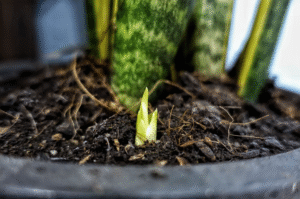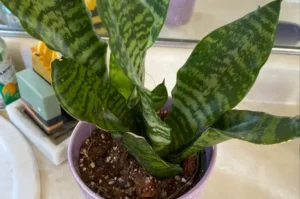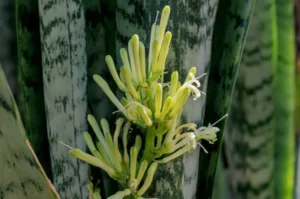Snake plants, also known as Sansevieria or mother-in-law’s tongue, are celebrated for their resilience and air-purifying qualities. Beyond their aesthetic appeal, they offer the added benefit of easy propagation. One of the most straightforward methods is water propagation, which allows you to witness root development firsthand.
This guide will walk you through the steps to propagate your snake plant in water, ensuring successful growth and a thriving indoor garden.
Why Choose Water Propagation?
While snake plants can be propagated through soil or division, water propagation offers distinct advantages:
- Visibility: Monitor root growth directly.
- Simplicity: Requires minimal materials.
- Cleanliness: Less mess compared to soil propagation.
Materials Needed
Before you begin, gather the following items:
- A healthy snake plant leaf
- Clean, sharp scissors or a knife
- A clear glass or jar
- Room-temperature water
- Optional: rooting hormone
Step-by-Step Guide to Water Propagation
1. Select a Healthy Leaf
Choose a mature, unblemished leaf from your snake plant. Avoid leaves that show signs of disease or damage.
2. Make the Cut
Using sterilized scissors or a knife, cut the leaf near its base. If desired, divide the leaf into 3–4 inch sections, ensuring you remember which end is the bottom.
3. Allow the Cuttings to Callus
Place the cuttings in a dry, shaded area for 1–2 days. This step helps prevent rot when the cuttings are placed in water.
4. Place Cuttings in Water
Fill a clear glass or jar with room-temperature water. Insert the cuttings, submerging only the bottom inch. Ensure the top part remains above water to prevent decay.
5. Provide Optimal Conditions
Position the container in a location with bright, indirect sunlight. Avoid direct sunlight, which can overheat the water and harm the cuttings.
6. Maintain Water Quality
Change the water every 4–7 days to keep it fresh and oxygenated. This practice reduces the risk of bacterial growth and promotes healthy root development.
7. Monitor Root Growth
Over the next few weeks, observe the emergence of roots from the cut end. Root development typically begins within 4–8 weeks, depending on environmental conditions.
8. Transition to Soil (Optional)
Once the roots are approximately 2 inches long, you can transplant the cutting into a pot with well-draining soil. Keep the soil slightly moist for the first couple of weeks to help the plant acclimate.
Common Mistakes to Avoid
- Over-submerging Cuttings: Only the bottom inch should be in water to prevent rot.
- Using Contaminated Tools or Containers: Always sterilize equipment and use clean containers to avoid introducing pathogens.
- Infrequent Water Changes: Regularly refresh the water to maintain oxygen levels and prevent bacterial buildup.
- Impatience: Root development takes time; avoid disturbing the cuttings unnecessarily.
Frequently Asked Questions (FAQs)
How long does it take for snake plant cuttings to root in water?
Root development typically occurs within 4–8 weeks, but it can vary based on environmental factors.
Can I use tap water for propagation?
Yes, but it’s advisable to let tap water sit for 24 hours to allow chlorine to dissipate, or use filtered water.
Do I need to use rooting hormone?
While not necessary, rooting hormone can expedite root growth.
When is the best time to propagate snake plants?
Spring and summer are ideal, as the plant is in its active growing phase.
Can I propagate variegated snake plants in water?
Yes, but note that new growth may not retain the variegation
Conclusion
Propagating a snake plant in water is a rewarding and straightforward process. With minimal materials and patience, you can expand your indoor garden and enjoy the satisfaction of nurturing new growth. Remember to provide the right conditions and care, and your propagated snake plants will thrive.






